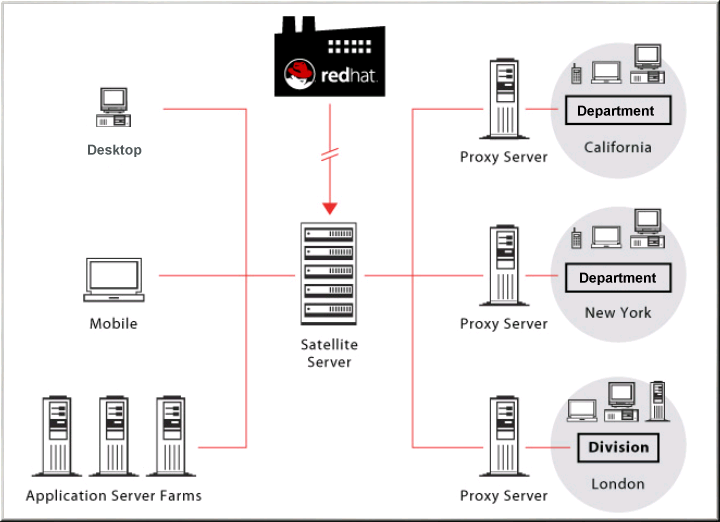このコンテンツは選択した言語では利用できません。
1.4. How it Works
RHN Satellite consists of the following components:
- Database — for the Stand-Alone Database, this may be the organization's existing database or, preferably, a separate machine. RHN Satellite supports Oracle Database 10g Release 2, Standard or Enterprise Edition. For the Embedded Database, the database comes bundled with RHN Satellite and is installed on the same machine as the Satellite during the installation process.
- RHN Satellite — core "business logic" and entry point for Red Hat Update Agent running on client systems. The RHN Satellite also includes an Apache HTTP Server (serving XML-RPC requests).
- RHN Satellite Web interface — advanced system, system group, user, and channel management interface.
- RPM Repository — package repository for Red Hat RPM packages and custom RPM packages identified by the organization.
- Management Tools:
- Database and file system synchronization tools
- RPM importing tools
- Channel maintenance tools (Web-based)
- Errata management tools (Web-based)
- User management tools (Web-based)
- Client system and system grouping tools (Web-based)
- Red Hat Update Agent on the client systems
The Red Hat Update Agent on the client systems must be reconfigured to retrieve updates from the organization's internal RHN Satellite instead of the central Red Hat Network Servers. After this one-time reconfiguration, client systems may retrieve updates locally using the Red Hat Update Agent, or system administrators may schedule actions through the RHN Satellite website.
Important
Red Hat strongly recommends that clients connected to RHN Satellite be running the latest update of Red Hat Enterprise Linux to ensure proper connectivity.
When a client requests updates, the organization's internal RHN Satellite queries its database, authenticates the client system, identifies the updated packages available for the client system, and sends the requested RPMs back to the client system. Depending upon the client's preferences, the package may also be installed. If the packages are installed, the client system sends an updated package profile to the database on the RHN Satellite; those packages are removed from the list of outdated packages for the client.
The organization can configure the website for the RHN Satellite to be accessible from the local area network only or from both the local area network and the Internet. The Satellite's version of the RHN website allows full control over client systems, system groups, and users.
The RHN Satellite management tools are used to synchronize the RHN Satellite database and package repository with Red Hat Network. The RHN Satellite import tool allows the system administrator to include custom RPM packages in the package repository.
RHN Satellite can be used in conjunction with RHN Proxy Server to deliver a distributed, self-contained Red Hat Network deployment for the organization. For example, an organization can maintain one RHN Satellite in a secure location. Red Hat systems with local network access to the RHN Satellite can connect to it. Other remote offices can maintain RHN Proxy Server installations that connect to the RHN Satellite. The different locations inside the organization must be networked, but this can be a private network; an Internet connection is not required for any of the systems. Refer to the RHN Proxy Server Installation Guide for more information.
Figure 1.1. Using RHN Satellite and RHN Proxy Server Together
